 With Twitter and Facebook entrenching themselves as the defacto social destinations for consumers there is a more quiet race betwen enterprise technology companies to position themselves as the next information hub for collaboration in the corporate world. I recently spent a tremendous amount of time with Cisco’s Murali Sitaram (pictured) the VP/GM of Cisco’s Enterprise Platforms unit to learn more about Cisco’s Quad initiative which ties together synchronous and asynchronous communications via a very social-networking friendly interface. The name Quad of course is a play on the campus quad which is often a meeting place at universities. And as you’ve no doubt guessed, the goal here is to create a virtual meeting place which has all the social benefits of the real-world coupled with the strengths of search, databases and real-time communications.
With Twitter and Facebook entrenching themselves as the defacto social destinations for consumers there is a more quiet race betwen enterprise technology companies to position themselves as the next information hub for collaboration in the corporate world. I recently spent a tremendous amount of time with Cisco’s Murali Sitaram (pictured) the VP/GM of Cisco’s Enterprise Platforms unit to learn more about Cisco’s Quad initiative which ties together synchronous and asynchronous communications via a very social-networking friendly interface. The name Quad of course is a play on the campus quad which is often a meeting place at universities. And as you’ve no doubt guessed, the goal here is to create a virtual meeting place which has all the social benefits of the real-world coupled with the strengths of search, databases and real-time communications.
Cisco Quad aims to unify synchronous and asynchronous communications
At the moment Quad is targeted at enterprises with 100,000 users and up and in the future we can expect a cloud-based Quad solution provided by service providers for smaller companies to use.
There are a few very real business reasons to seriously consider enterprise social networking and without a doubt providing a familiar workspace for the “Facebook generation” is one. Beyond that it is apparent to me after a brief demo of Quad that enterprise social networks can become a living and breathing repository of knowledge and business process. The productivity benefits of being able to research past mistakes in excruciating detail to avoid repeating them cannot be underestimated.
And of course you can analyze your past successes as well and hopefully repeat them across workgroups.
Cisco supplied some screen shots and the text in the green boxes is from them. I deemed these descriptions useful and devoid of excess marketing spin so I left them in. Click on any image below to enlarge.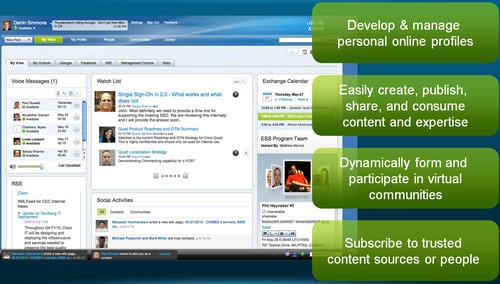
One other reason for adopting a business-oriented social network platform is the retirement of the baby boomer generation – a full 10,000 (PDF) baby boomers per month will be eligible for retirement as of January 2011. The question companies need to ask themselves is how do they keep the knowledge and expertise of these retirees in a form which can be leveraged in the future?
Cisco hasn’t directly acquired the technology behind Quad but it has a string of dozens of acquisitions which amplify the usefulness of the new service and Sitaram told me they are building an architectural pillar which chases after the collaboration market estimated to be worth $38B in 2012.
To me, Quad seems like the interface of an iPad – simple on the outside yet infinitely complex behind the scenes. When using it you get the sense you are using a social network which Apple had a small part in designing but unlike many Apple and even traditional Cisco solutions there seems to be a more open ecosystem approach to Quad than you might expect.
Now I know what you’re thinking and you are absolutely correct. How many companies have tried to launch the next big thing in communications and failed. Perhaps the biggest recent example of failure is Google Wave which was supposed to transform our communications in a similar manner to how Google transformed our searches. We expected this fusion of social networking and email to take the world by storm and it just didn’t. Perhaps it was the confusing UI or perhaps it was the complexity of it all.
I asked Sitaram his thoughts on the failure of Wave and he said that while it tried to enhance e-mail, Quad is trying to change the way people work. He went on to say Wave was one-dimensional and that in order to be successful there needs to be cultural and process change. He said companies need to tear down their intranets and rate employees based on their participation. He further mentioned the transition is a 3-5 year process.
Cisco has experience in using this approach as the company is transitioning its intranet to Quad over the next 2-3 quarters. As you may recall the company also rolled out IP telephony internally fairly early – around eight years ago, as a proof of concept for its customers. This is a smart move by the networking giant and it further allowed Sitaram to show me the features of the system via his own account and he was able to inject the passion and enthusiasm which any proud parent would display when doing a demo.
It seems like a good time to relay some of the things Quad can do for an enterprise. First off it allows a user to update their microblog status like Twitter for the enterprise provider Yammer. There is also Twitter integration and by selecting a checkbox you can enable your status to be broadcast across the open web. Moreover there is a personalized dashboard which can contain custom apps and the calendar seamlessly integrates with Microsoft Outlook while presence integrates with Microsoft OCS (Tom Keating has a scoop this product has been renamed Microsoft Lync). Moreover there is integration with SharePoint and Microsoft FAST Search Server.
I mentioned the open ecosystem above and Sitaram reinforced the point by mentioning Cisco’s goal is to leverage the tools companies have but make them better. For example you can see photos of people coming to your meetings and a click of the mouse allows you to IM via Webex or call them. This by the way is where the asynchronous worl
d becomes synchronous as video and audio communication is seamlessly built into the system meaning you can think of Quad as your corporate Facebook and Skype rolled into one. This is an oversimplification but it gives you a good idea of how Quad can change communications for the better.
Other important features include a visual voicemail widget, RSS feeds and iGoogle support. As you might expect you can list your interests and further view the reporting structure of others. Moreover you can (depending on privacy settings, etc) view the WebEx, telepresence meetings and shared documents of others.
Moreover there is community support allowing conversations to take place on various topics. These communities can be open, direct-invite or hidden – as you would likely want to do when dealing with a confidential topic like an acquisition or merger. You can further allow partners and contractors into Quad and of course permissions play a crucial role in allowing them access to just the information they require. Furthermore, the system supports tags and as a result allows a tag cloud to be built and searched upon. This could come in handy if you are looking for a PowerPoint on virtualization security which is recent.
How Cisco views Quad fitting into the enterprise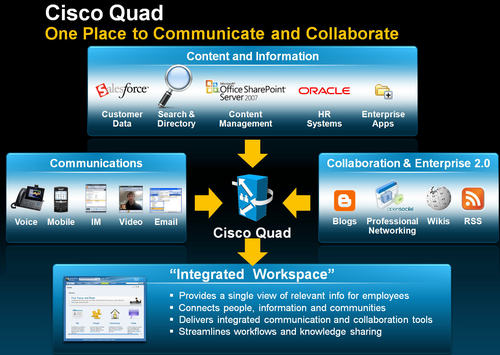
Information as you can imagine is not just pulled from the system – you can build default lists when sharing – allowing you to quickly ensure the appropriate people are kept up to speed.
It goes without saying but is important enough to specify the system can be the centerpiece of your internal video distribution as well like a corporate YouTube.
In terms of security – the solution currently only works via VPN – or within the firewall and all you need is a browser – no local applications need to be installed.
One important question I had was what category Quad fits in and I was told Quad could be considered enterprise social software but is broader and crosses over into enterprise content management, search and unified communications.
I next asked how Quad competes with SharePoint, the Google Search Appliance and Salesforce.com’s Chatter. The response was that none of these systems include real-time collaboration – the ability to immediately initiate a real-time collaboration. Murali explained that SharePoint is a toolset while Quad is an out-of-the-box solution. Moreover, he added that Cisco has embedded policy and security into their system – in-part thanks to their acquisition of Securant a company focusing on the entitlement management space.
He went on to say the system includes semantic search which of course pits them against Google in the enterprise space. Other benefits of Quad over the competition according to Sitaram include allowing organizations better control of their data – a single copy of documents with versioning and comments preserved. Moreover, they are working on iPad and iPhone apps as well which they say Microsoft is less likely to do. He went on to say, “Cisco wants to be an any to any company.”
A final differentiator was that Quad will be one of the first apps on the new Cius tablet.
I further asked why there is no project management in Quad and he said this is a direction the company would like to go in. This led to a discussion of the included open APIs which allows a company to tailor the system to vertical markets such as insurance.
I asked how Quad compares to wikis and he said that one of the benefits of Quad is the ease in which you can find content.
I also asked about the perception of Facebook being a time drainer – after all, even actress Betty White thinks this about Facebook. This one was diffused quickly as Sitaram explained all the content in Quad is work-related.
I next asked if people will jump off FaceBook and Twitter and the response was that people will go where their work lives and they will further need to “Quad” to find documents and this will allow them to work faster and more efficiently as they will now have more rapid access to documents.
I also asked if Cisco uses Yammer and was told they do and it will be replaced by Quad – he further went on to say this about the enterprise microblog service – information once it scrolls off the screen is useless. It is worth mentioning Yammer does have a search feature and is very similar to Twitter in most respects.
From there we went into a discussion of productivity as I asked about how you can prove ROI with such a system. This question occurred to me as Sitaram explained a bit earlier that a county in the UK they are working with has deployed Quad as part of a solution which saves 50 million pounds annually. One reason the Cisco solution was deployed had to do with allowing workers who were once in offices to work from home while feeling a sense of community.
As many cities, counties and countries find themselves with massive amounts of debt they may never be able to pay back, one has to wonder if selling off real-estate and using collaboration is the smartest way global governments can streamline themselves without implementing ever-more suffocating taxes on the most productive elements of their societies.
Perhaps the most interesting part of the meeting was learning how passionate Sitaram is about Quad. He truly believes its what’s next with IP communications. He exclaimed, “This is what sits on top of it!”
We are confronted with new paradigms and technologies on a monthly basis it seems and some become hugely successful and others like virtual worlds utilizing avatars gain rapid momentum and then fade.
After seeing Quad in action it is obvious that a system like this is the future of collaboration and communications. I don’t see email going away in the foreseeable future but we have seen that collaboration technologies like web conferencing, IM/presence, SharePoint,Facebook, Yammer and Twitter are flourishing. Doesn’t it make perfect sense that there needs to a be a single data store and set of access policies for all collaboration information which is accessible by a clean and uncluttered web-based GUI? Of course.
I am bullish on the prospects of Quad but I am also cautious as predicting time frames for technological leaps which require user behavior to change as this is an easy way to destroy a writer’s credibility. Moreover, what is there to stop Google, Salesforce.com, Microsoft, Facebook and/or Twitter from evolving to target Quad? And then there is Oracle, IBM and HP – don’t expect them to sit down and watch a lucrative new market get taken away by another company. And if competition heats up will it splinter the market causing it to slow down or speed up? So I will end by stating simply a collaboration solution like Quad is likely the future of enterpris
e communications and for now Cisco seems to be even better positioned to differentiate itself in global enterprises and soon SMBs.

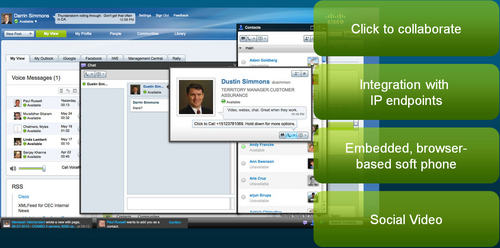
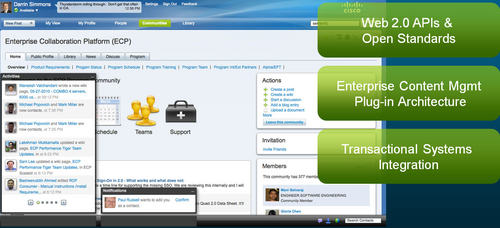
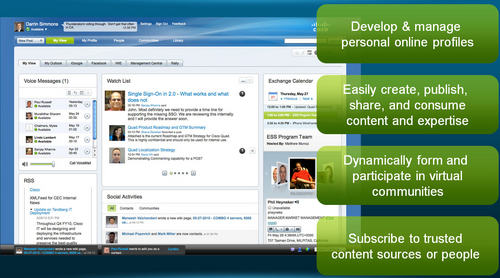

Shelby
September 16, 2010 at 8:09 pmThe unified communications have really changed the world by allowing people to communicate in a different manner to be more efficient!
Related Articles
Vonage Elevates Cloud Communications with Advanced Noise Cancellation and AI Integration
How LeapXpert Combines Consumer Messaging with Enterprise Security and Compliance
GTT Communications: Pioneering the Future of Managed Network and Security Services